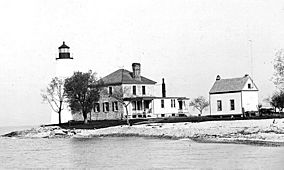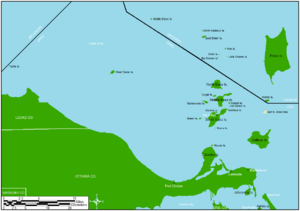West Sister Island facts for kids
Quick facts for kids West Sister Island National Wildlife Refuge |
|
|---|---|
|
IUCN Category IV (Habitat/Species Management Area)
|
|

West Sister Light with Keeper's Dwelling
|
|
| Lua error in Module:Location_map at line 420: attempt to index field 'wikibase' (a nil value). | |
| Location | Jerusalem Township, Lucas County, Ohio, United States |
| Nearest city | Toledo, Ohio |
| Area | 77 acres (31 ha) |
| Established | 1937 |
| Governing body | U.S. Fish & Wildlife Service |
| Website | West Sister Island National Wildlife Refuge |
West Sister Island is a small island in Lake Erie, located in the state of Ohio, United States. It is about 82 acres (33 hectares) in size. The island is special because it is Ohio's only official Wilderness Area. This means it is kept wild and natural to protect its plants and animals. It is called the West Sister Island National Wildlife Refuge.
The island is mostly covered with trees, especially tall hackberry trees. You can also find many ferns, wildflowers, and mushrooms growing there. It is home to lots of poison ivy, so it's best to stay away from it!
West Sister Island is part of a group of islands called the Pelee Archipelago. This group also includes East Sister Island and Middle Sister Island, which are in Canada. West Sister Island is located about 13 miles west of Rattlesnake Island and almost 9 miles north of the Ohio mainland.
Contents
The West Sister Island Lighthouse
A lighthouse was built on West Sister Island in 1848. Its job was to guide boats safely through the western part of Lake Erie. The lighthouse is made of stone and brick. It stands 55 feet (17 meters) tall.
The West Sister Island Lighthouse is still working today. It helps ships navigate the lake. It is one of the oldest lighthouses still standing on the Great Lakes.
Island History
West Sister Island became a wildlife refuge in 1937. But during World War II, the United States Army used the island for target practice. Even with the training, the wildlife and the lighthouse were not badly harmed. However, the house where the lighthouse keeper lived was destroyed. People say that old fuel tanks dropped by planes can still be found on the island.
The island was also a popular spot for people who illegally transported alcohol during a time called Prohibition. This was when alcohol was against the law in the United States. These people, sometimes called "rum runners," would use the island to hide from authorities. Legend says that bottles of old alcohol can still be found at the bottom of the lake around the island.
West Sister Island National Wildlife Refuge
President Franklin D. Roosevelt created the West Sister Island National Wildlife Refuge in 1937. He wanted to protect a safe place for migratory birds and other wildlife to live and raise their young. The refuge is especially important for wading birds. It has the largest colony of nesting wading birds in the U.S. Great Lakes region.
The refuge is managed by the staff of the Ottawa National Wildlife Refuge. It is kept as a wilderness area. To protect the birds and their habitat, people are usually not allowed to visit the island. Only researchers can go there for studies.
The refuge covers about 80 acres (32 hectares). In 2000, it was recognized as an important area for birds worldwide. West Sister Island provides nesting spots for 40% of all the herons and egrets that nest in the U.S. Great Lakes.
West Sister Island in Popular Culture
The wildlife refuge was shown in a 2007 episode of the TV show Dirty Jobs. The host, Mike Rowe, visited the island. Because of the many birds on the island, it was called "Vomit Island" in the show. This was due to birds vomiting from high in the trees.
In the cartoon TV series Transformers Animated, there is a fictional island called "North Sister Island" in Lake Erie. This island is a safe place for the Dinobots. It is a fun reference to the real West Sister Island.
Images for kids




